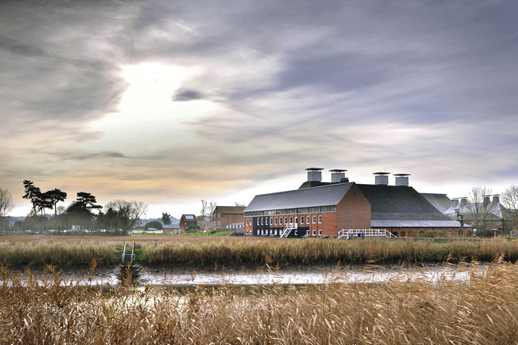 Snape Maltings from across the River Alde. Photo: Philip Vile
Snape Maltings from across the River Alde. Photo: Philip Vile
A review by James Canton
Snape Maltings – tucked into the reed beds of east Suffolk – is the home of Place, an annual arts-based weekend of talks, films and cultural discussion. This year the theme was Roots – Journeying Home. Overseen by the gentle ghostly presence of Benjamin Britten the weekend is curated by the organiser and co-ordinator extraordinaire Gareth Evans alongside the man who makes Aldeburgh Music happen, Jonathan Reekie. Together, they produced an irresistible feast of events.
On the Friday evening there are soundscapes recorded by Chris Watson from the footpaths of the composing walks Britten took daily on his beloved Suffolk coast; sculpted by Tony Myatt (spatial audio programmer) into a shell of bird song, stone shuffle, reed rustle, animal calls. On Saturday, we learn more of Britten from his biographer Paul Kildea, catching glances of the composer in East Coast America in 1940 with W. H Auden, in a house stuffed with writers, artists even a stripper called Rosie Lee. But we return soon enough, as Britten did, to Suffolk as Kildea has the entire audience of the Concert Hall singing Britten’s ‘The Ash Grove’. It is that kind of weekend. Full of brilliant treats and surprises; never staid and dull. In the gathering places, people greet old friends, or make new ones, chat on the art, the talks in a spirit of collective creative wonderment.
Marina Warner mesmerised all with her talk on ‘Apocryphal Landscapes and Narrative Ghosts’ a perfect dissection of our secular times, with its need for the moment of remembrance, for anniversaries to mark events such that we can gather ‘re-animating the voices of the dead’. What spooks us now is not the stories of M. R. James, but ‘a terror of collective forgetting’. How poignant in the week we recall the Great Flood of 1953 – sixty years before – a memorial nightmare for East Anglia that Blake Morrison will remind us of on Sunday. Then the beloved figure of Ronald Blythe stepped up and offered a personal memoir of Britten, of time here in the 1950s working with the great man and an anecdote of a note from E. M. Forster to the young Blythe to come for drinks.
And it was only lunch on Saturday. There were films to watch – a showing of Patrick Keillor’s The Dilapidated Dwelling (2000) with its prototype Robinson; art installations to see and hear. Over in the Dovecote Studio is Mikhail Karikis’ extraordinary Sea Women. The only concern was fitting food in.
Patrick Wright talked with typical brilliance on Uwe Johnson, the German writer who settled in Sheerness for the last ten years of his life, reminding all that home may certainly not be where we were born. Some of the films of Margaret Tait followed; introduced by Ali Smith, before the publisher Liz Calder of Full Circle shared a conversation with the writer Jennifer Potter. In the evening a world premier showing of Ben Rivers’ recent Two Years at Sea (2012) unfurled to a live score from Talvin Singh, sat before the audience in a circle of tabla or drums.
Sunday offered more treats. Those up early got the guided walk of Aldeburgh with Chris Watson; others gathered later for tales of the Haggerston Estate in Hackney. Andrea Luka Zimmerman told of replacing the bland orange boards placed by the council over unoccupied flat windows with bold portraits of the block’s human inhabitants. The images are startlingly emotive. Home is here – where we sit in a landscape – be it rural or urban. Ken Worpole posed the question facing urban planners across Britain: ‘how do we create decent housing … a place to live in the world?’ Later, Geoff Dyer spoke on ‘Rootedness and Roaming’ letting us wander to New Mexico where we heard of D. H. Lawrence’s tempestuous outbursts, his love of housework and reluctance to own a home. Finally, Ruth Padel saw home in the journey of migrations of both birds and people, teasing with half-told tales of Bar-headed Geese rising over Mount Everest, before bringing us back to earth with lines on Sans Gatte.
When the talkers fell silent on Sunday afternoon, there were still Hugh Pilkington’s images of the 1953 Flood to see, Giles Round’s sculptures born from the domestic accoutrements of Britten’s Red House in Aldeburgh. Such is the flavour of the Place weekender. Brush shoulders with artists, writers, cultural commentators. Savour some moments out in the reed beds and step back into the events unfolding in the various buildings that once were the maltings that now vibrate to words, thoughts, ideas shared. Then leave for home.
